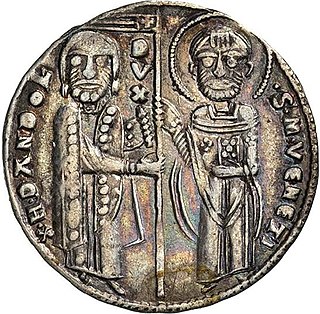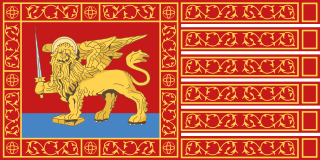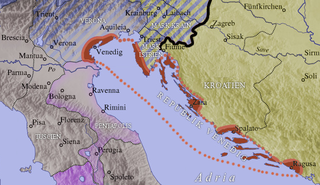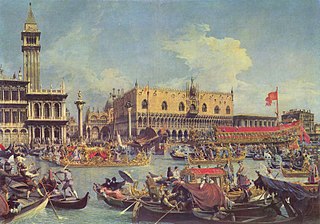
The Doge of Venice was the highest role of authority within the Republic of Venice. The word Doge derives from the Latin Dux, meaning "leader," originally referring to any military leader, becoming in the Late Roman Empire the title for a leader of an expeditionary force formed by detachments from the frontier army, separate from, but subject to, the governor of a province, authorized to conduct operations beyond provincial boundaries.

Enrico Dandolo was the doge of Venice from 1192 until his death in 1205. He is remembered for his avowed piety, longevity, and shrewdness, and his role in the Fourth Crusade and the Sack of Constantinople. Dandolo died in 1205 in Constantinople and was buried at the Hagia Sophia.

The Lido, or Venice Lido, is an 11-kilometre-long (7-mile) barrier island in the Venetian Lagoon, Northern Italy; it is home to about 20,400 residents. The Venice Film Festival takes place at the Lido in late August/early September.

Pietro II Orseolo (961−1009) was the Doge of Venice from 991 to 1009, and a member of the House of Orseolo. He began the period of eastern expansion of Venice that lasted for the better part of 500 years. He secured his influence in the Dalmatian Romanized settlements from the Croats and Narentines, freed Venetia from a 50-year-old taxation to the latter, and started Venetia's expansions by conquering the islands of Lastovo (Lagosta) and Korčula (Curzola) and acquiring Dubrovnik (Ragusa).

The Republic of Venice, officially the Most Serene Republic of Venice and traditionally known as La Serenìssima, was a sovereign state and maritime republic with its capital in Venice. Founded, according to tradition, in 697 by Paolo Lucio Anafesto, over the course of its 1,100 years of history it established itself as one of the major European commercial and naval powers. Initially extended in the Dogado area, during its history it annexed a large part of Northeast Italy, Istria, Dalmatia, the coasts of present-day Montenegro and Albania as well as numerous islands in the Adriatic and eastern Ionian seas. At the height of its expansion, between the 13th and 16th centuries, it also governed the Peloponnese, Crete and Cyprus, most of the Greek islands, as well as several cities and ports in the eastern Mediterranean.

The bucentaur was the ceremonial barge of the doges of Venice. It was used every year on Ascension Day up to 1798 to take the doge out to the Adriatic Sea to perform the "Marriage of the Sea" – a ceremony that symbolically wedded Venice to the sea.

Bucentaure was an 86-gun ship of the line of the French Navy, and the lead ship of her class. She was the flagship of Vice-Admiral Latouche Tréville, who died on board on 18 August 1804, and later of Vice-Admiral Pierre-Charles Villeneuve as the flagship of the Franco-Spanish fleet at the Battle of Trafalgar.

The House of Orseolo was a powerful Venetian noble family descended from Orso Ipato and his son Teodato Ipato, the first Doges of Venice. Four members of the Orseolo family became Doges, Commander of the Venetian fleet, and King of Hungary. They reconstructed St Mark's Basilica and the Doge's Palace after the revolution.

The Republic of Venice was a sovereign state and maritime republic in Northeast Italy, which existed for a millennium between the 8th century and 1797.

San Nicolò al Lido refers to both the San Nicolò Church and most importantly to its annexed Monastery of San Nicolò located in Venice, northern Italy. The two Catholic institutions are located in the northern part of the Lido di Venezia and house the relics of Saint Nicholas, patron of sailors. From this church, the traditional thanksgiving Mass of the Sposalizio del Mare is celebrated. The complex houses monks of the Franciscan order.

Malamocco was the first, and for a long time, the only, settlement on the Lido of Venice barrier island of the Lagoon of Venice. It is located just south of the island's center and it is part of the Lido-Pellestrina borough of the municipality of Venice.
This article presents a detailed timeline of the history of the Republic of Venice from its legendary foundation to its collapse under the efforts of Napoleon.

The Compagnie della Calza were theatrical associations in Venice in the 15th and 16th centuries. The members wore distinctive hosiery which gave them their name and met to arrange entertainments such as feasts and games.

The Doge on the Bucintoro near the Riva di Sant'Elena is an oil painting on canvas by the Venetian painter Francesco Guardi. It was painted between 1775 and 1780, and is now in the Louvre in Paris.

Traditions of Italy are sets of traditions, beliefs, values, and customs that belongs within the culture of Italian people. These traditions have influenced life in Italy for centuries, and are still practiced in modern times. Italian traditions are directly connected to Italy's ancestors, which says even more about Italian history.

The Fèsta de ƚa Sènsa was a feast of the Republic of Venice held on the occasion of the feast of the Ascension and still celebrated as a recreation today. It commemorated two significant dates in the Republic's history; the first being May 9, 1000, when the Doge Pietro II Orseolo rescued the denizens of Dalmatia imperiled by the Slavs. The aforementioned date marked the onset of Venetian extension in the Adriatic.

The Diocese of Castello, originally the Diocese of Olivolo, is a former Roman Catholic diocese that was based on the city of Venice in Italy. It was established in 774, covering the islands that are now occupied by Venice. Throughout its existence there was tension between the diocese, the Patriarchate of Grado to which it was nominally subordinate, and the Doge of Venice. Eventually in 1451 the diocese and the patriarchate were merged to form the Archdiocese of Venice.
The Podestà of Constantinople was the official in charge of Venetian possessions in the Latin Empire and the Venetian quarter of Constantinople during the 13th century. Nominally a vassal to the Latin Emperor, the Podestà functioned as a ruler in his own right, and answered to the Doge of Venice. The Podestà was also officially known as Governor of One-Fourth and One-Half of the Empire of Romania and was entitled to wearing the crimson buskins as the emperors.
This is an alphabetical index of people, places, things, and concepts related to or originating from the Republic of Venice. Feel free to add more, and create missing pages.

The corno ducale, a unique ducal hat, was the headgear and symbol of the Doge of Venice. It was a stiff horn-like bonnet, which was made of gemmed brocade or cloth-of-gold and worn over a camauro. The ducal horn was a fine linen cap with a structured peak at the back reminiscent of the Phrygian cap, a classical symbol of liberty.


















